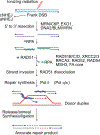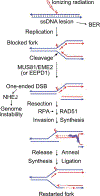Roles of homologous recombination in response to ionizing radiation-induced DNA damage
- PMID: 34283012
- PMCID: PMC9629169
- DOI: 10.1080/09553002.2021.1956001
Roles of homologous recombination in response to ionizing radiation-induced DNA damage
Abstract
Purpose: Ionizing radiation induces a vast array of DNA lesions including base damage, and single- and double-strand breaks (SSB, DSB). DSBs are among the most cytotoxic lesions, and mis-repair causes small- and large-scale genome alterations that can contribute to carcinogenesis. Indeed, ionizing radiation is a 'complete' carcinogen. DSBs arise immediately after irradiation, termed 'frank DSBs,' as well as several hours later in a replication-dependent manner, termed 'secondary' or 'replication-dependent DSBs. DSBs resulting from replication fork collapse are single-ended and thus pose a distinct problem from two-ended, frank DSBs. DSBs are repaired by error-prone nonhomologous end-joining (NHEJ), or generally error-free homologous recombination (HR), each with sub-pathways. Clarifying how these pathways operate in normal and tumor cells is critical to increasing tumor control and minimizing side effects during radiotherapy.
Conclusions: The choice between NHEJ and HR is regulated during the cell cycle and by other factors. DSB repair pathways are major contributors to cell survival after ionizing radiation, including tumor-resistance to radiotherapy. Several nucleases are important for HR-mediated repair of replication-dependent DSBs and thus replication fork restart. These include three structure-specific nucleases, the 3' MUS81 nuclease, and two 5' nucleases, EEPD1 and Metnase, as well as three end-resection nucleases, MRE11, EXO1, and DNA2. The three structure-specific nucleases evolved at very different times, suggesting incremental acceleration of replication fork restart to limit toxic HR intermediates and genome instability as genomes increased in size during evolution, including the gain of large numbers of HR-prone repetitive elements. Ionizing radiation also induces delayed effects, observed days to weeks after exposure, including delayed cell death and delayed HR. In this review we highlight the roles of HR in cellular responses to ionizing radiation, and discuss the importance of HR as an exploitable target for cancer radiotherapy.
Keywords: DNA double-strand breaks; DNA repair; cancer radiotherapy; homologous recombination; ionizing radiation; replication stress.
Conflict of interest statement
Disclosure of interest
The authors report no conflict of interest.
Figures





Similar articles
-
Metnase and EEPD1: DNA Repair Functions and Potential Targets in Cancer Therapy.Front Oncol. 2022 Jan 28;12:808757. doi: 10.3389/fonc.2022.808757. eCollection 2022. Front Oncol. 2022. PMID: 35155245 Free PMC article. Review.
-
Analysis of chromatid-break-repair detects a homologous recombination to non-homologous end-joining switch with increasing load of DNA double-strand breaks.Mutat Res Genet Toxicol Environ Mutagen. 2021 Jul;867:503372. doi: 10.1016/j.mrgentox.2021.503372. Epub 2021 Jun 12. Mutat Res Genet Toxicol Environ Mutagen. 2021. PMID: 34266628
-
Single-strand annealing, conservative homologous recombination, nonhomologous DNA end joining, and the cell cycle-dependent repair of DNA double-strand breaks induced by sparsely or densely ionizing radiation.Radiat Res. 2009 Mar;171(3):265-73. doi: 10.1667/RR0784.1. Radiat Res. 2009. PMID: 19267553
-
The role of nonhomologous DNA end joining, conservative homologous recombination, and single-strand annealing in the cell cycle-dependent repair of DNA double-strand breaks induced by H(2)O(2) in mammalian cells.Radiat Res. 2008 Dec;170(6):784-93. doi: 10.1667/RR1375.1. Radiat Res. 2008. PMID: 19138034
-
Roles for 53BP1 in the repair of radiation-induced DNA double strand breaks.DNA Repair (Amst). 2020 Sep;93:102915. doi: 10.1016/j.dnarep.2020.102915. DNA Repair (Amst). 2020. PMID: 33087281 Review.
Cited by
-
Rapid P-TEFb-dependent transcriptional reorganization underpins the glioma adaptive response to radiotherapy.Nat Commun. 2024 May 30;15(1):4616. doi: 10.1038/s41467-024-48214-3. Nat Commun. 2024. PMID: 38816355 Free PMC article.
-
New Facets of DNA Double Strand Break Repair: Radiation Dose as Key Determinant of HR versus c-NHEJ Engagement.Int J Mol Sci. 2023 Oct 6;24(19):14956. doi: 10.3390/ijms241914956. Int J Mol Sci. 2023. PMID: 37834403 Free PMC article. Review.
-
SRSF2 overexpression induces transcription-/replication-dependent DNA double-strand breaks and interferes with DNA repair pathways to promote lung tumor progression.NAR Cancer. 2025 Apr 2;7(2):zcaf011. doi: 10.1093/narcan/zcaf011. eCollection 2025 Jun. NAR Cancer. 2025. PMID: 40181846 Free PMC article.
-
Combining Carbon-Ion Irradiation and PARP Inhibitor, Olaparib Efficiently Kills BRCA1-Mutated Triple-Negative Breast Cancer Cells.Breast Cancer (Auckl). 2022 Mar 23;16:11782234221080553. doi: 10.1177/11782234221080553. eCollection 2022. Breast Cancer (Auckl). 2022. PMID: 35340889 Free PMC article.
-
Progression in low-intensity ultrasound-induced tumor radiosensitization.Cancer Med. 2024 Jul;13(13):e7332. doi: 10.1002/cam4.7332. Cancer Med. 2024. PMID: 38967145 Free PMC article. Review.
References
-
- Allen C, Halbrook J, Nickoloff JA. 2003. Interactive competition between homologous recombination and non-homologous end joining. Mol Cancer Res. 1:913–920. - PubMed
Publication types
MeSH terms
Grants and funding
LinkOut - more resources
Full Text Sources
